Catalogue > Liste par artiste
Parcourez la liste complète des artistes présentés dans le cadre des Rencontres Internationales depuis 2004. Utilisez le filtre alphabétique pour affiner vos recherches.
Anthony Mccall
Catalogue : 2010You and I | 0 | 0 | | 0:0 | USA | 2010
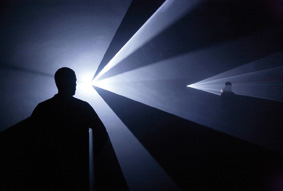
Anthony Mccall
You and I
0 | 0 | | 0:0 | USA | 2010
Anthony Mccall
Catalogue : 2007Line Describing a Cone | Film expérimental | 16mm | noir et blanc | 30:0 | France, USA | 1973
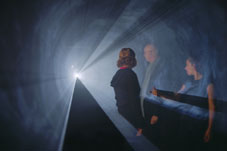
Anthony Mccall
Line Describing a Cone
Film expérimental | 16mm | noir et blanc | 30:0 | France, USA | 1973
A l?espace perspectif et illusionniste conventionnel qui rabat le cinéma sur la peinture, les films de McCall substituent un espace projectif qui le ramène à la sculpture. Désormais le film n?est plus cette image projetée qui creuse dans la surface du mur une profondeur fictive mais un champ réellement constitué qui se confond avec l?événement de la projection même. C?est ainsi que les faisceaux lumineux découpés dans la fumée d?Anthony McCall, développant les propriétés proprement plastiques du film, passent les frontières de l?histoire du cinéma pour rejoindre les propositions minimalistes de la sculpture des années 70 et s?inscrire à côté des structures géométriques de Robert Morris, Saul Le Witt, ou Carl Andre, des champs colorés de Dan Flavin ou des fils de coton coloré tendus dans l?espace de Fred Sandback. Au commencement des années 2000, après un silence de 20 années et alors que les présentations des Solid Light Films se multipliaient aux Etats-Unis comme en Europe, Anthony McCall inaugurait une nouvelle série d??uvres réalisée non plus sur support argentique, mais en numérique, l?ordinateur lui permettant de concevoir des tracés complexes, et d?explorer les propriétés plastiques des lignes ondulantes : alors que les pièces géométriques des années 70 se fondaient sur un principe d?équivalence entre la ligne et le plan, les pièces néo-géométriques des années 2000 jouent de la réversibilité des formes, des échanges entre intérieur et extérieur ou encore de l?équivalence des vecteurs horizontaux et verticaux. Simultanément, la substitution aux machines à fumées traditionnelles de brumisateurs diffusant de la vapeur d?eau produisant une texture plus uniforme à plus grand échelle permettait à McCall de démultiplier la taille de ses pièces désormais conçues A l?espace perspectif et illusionniste conventionnel qui rabat le cinéma sur la peinture, les films de McCall substituent un espace projectif qui le ramène à la sculpture. Désormais le film n?est plus cette image projetée qui creuse dans la surface du mur une profondeur fictive mais un champ réellement constitué qui se confond avec l?événement de la projection même. C?est ainsi que les faisceaux lumineux découpés dans la fumée d?Anthony McCall, développant les propriétés proprement plastiques du film, passent les frontières de l?histoire du cinéma pour rejoindre les propositions minimalistes de la sculpture des années 70 et s?inscrire à côté des structures géométriques de Robert Morris, Saul Le Witt, ou Carl Andre, des champs colorés de Dan Flavin ou des fils de coton coloré tendus dans l?espace de Fred Sandback.
Steven Mccarthy
Catalogue : 2007Commercial rhetoric art project | Vidéo expérimentale | dv | couleur | 7:30 | USA | 2005
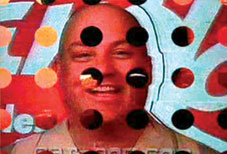
Steven Mccarthy
Commercial rhetoric art project
Vidéo expérimentale | dv | couleur | 7:30 | USA | 2005
"Commercial Rhetoric Art Project" utilise la matière visuelle destinée aux marchés domestiques afin de créer une oeuvre recontextualisée en un énoncé social, politique et économique. En démantelant et réorganisant les messages commerciaux censés nous séduire, nous clients potentiels, le projet amène les spectateurs à questionner la rhétorique qui tente de coloniser nos foyers. Stratégie de collage, de juxtaposition, de satire et de parodie servent à inverser le mouvement dominant de la propagande publicitaire qui s'invite dans nos espaces privés. Une série de collages créés à partir de prospectus, des assemblages d'emballages de produits et de nourriture, reconfigurés dans des habillements marqués, des publicités digitalement remixées, des sites de web et des "spams" (des courriers indésirables) - "Commercial Rhetoric Art Project" utilise toute publicité indésirable dans son fourrage. Certains de ces objets fabriqués sont purement esthétiques, des critiques, consommateurs de culture et autres esquissent une fonctionnalité alternative. Plus de 100 publicités destinées à la télévision ont été enregistrées, éditées et remixées en 7 vidéos digitales courtes. Cette gamme de compilations dont la longueur varie de 30 à 90 secondes emploie différents montages visuels et structures narratives. Avec des thèmes récurrents tels que le désir sexuel, le drame familial, fétichisation du produit, nourriture, luxure et figure d'autorité de persuasion qui sont extraites pour en dénoncer le ridicule.
Steven McCarthy a obtenu une Maitrise de Graphisme (Design) à l' Université de Stanford, un programme hybride entre le "Département d' Art et d' Ingénierie" et une "Licence des Beaux-Arts" specialisé dans la sculpture et dessin à l'Université de Bradley. Il est actuellement professeur-associé de studio-graphique à l'Université du Minnesota, Twins City Campus. Ses actuelles recherches créatives se soucient de raconter des histoires et de fournir des expériences intéractives dans l'environnement digital de nos jours. Toutefois, son souci premier concerne la condition humaine- la technologie et les moyens lui importent peu. Le graphisme autodidacte de Steven a été publié dans "Graphis Poster", le "American Institute of Graphic Arts annual" et dans "Provocative Graphics: The Power of the Unexpected in Graphic Design". Ses registres sont dans de nombreux collections dont: le "Museum of Modern Art", le "Banff Centre" au Canada, le "Sackner Archive of Visual and Concrete Poetry", et la "Houghton Library" à l' Université de Harvard. Ses oeuvres intéractives ont été performées /exposées internationalement, avec des représentations récentes au "VideoFormes", France, FILE 2003, 2004 & 2006 (le Festival International du Langage Electronique), São Paulo, et le Festival d'Images 2005,de Toronto. Présentations récentes et conférences de Design dont "Declarations", Montréal (2001), "Mind the Map", Istanbul (2002), "Hidden Typography", Londres (2003), "Politics of Design", Belfast (2004), New Views, Londres(2005) et "Wonderground", Lisbonne (2006). Steven a aussi publié des articles en tant qu'examinateur-expert dans des journaux académiques. Pour en savoir plus sur Steven et son oeuvre, visitez son site personnel: http://www.episodic-design.com.
Cal Mccormack
Catalogue : 2022Agony to Ecstasy | Doc. expérimental | mp4 | couleur et n&b | 12:50 | Royaume-Uni | 2020
Cal Mccormack
Agony to Ecstasy
Doc. expérimental | mp4 | couleur et n&b | 12:50 | Royaume-Uni | 2020
‘Agony to Ecstasy’ looks at the scope of the socio-addictive condition within Scottish people. It focuses on the relationship between pain and pleasure, between stress and relief and between entrapment and escape. The film in many ways, is a dissection of two spaces – euphoric clubbing and silent Scottish nature, offering a perspective on our need for salvation within both. Neurologically, there is very little difference between the brain addicted to something, as to when falling in love. As a result, the film fluctuates between these neurological and personal perspectives on addiction and connection – where their conflating and often paradoxical relationship are juxtaposed. The film is made with reflection as its key focus. Made during the middle of the first lockdown, it uses the collective state of withdrawal and loneliness to observe realities within clubs. A slow-motion strobe follows the film throughout, as a visual deconstruction of the joy, yet ghostly inhibition of the people in the shots. Vulnerability was key in Dej’s recollections – his words occupy the emotional worlds of mental health, stigma and the ecstasy of clubbing, without having a particular stance or opinion. Ultimately 'Agony to Ecstasy' looks beyond fixed stereotypes of addicts, and into the dependencies, shame and love between Scottish people.
Cal Mac is a visual artist working and living in Glasgow. Working between sculpture print and video, he explores themes of belonging and addiction through sociological, scientific and visual dialogues. His work often looks at clubbing and natural environments, to unravel truths about our current condition and need for connection. His work has been screened at Atlas Arts (skye), The Royal Scottish Academy (Edinburgh), Limerick Institute of Technology, and online for Lift off Festival, and Film and Video Umbrella. Following his first commission from Film and Video Umbrella in 2020, Mac has done residencies at Cove Park and Edinburgh Sculpture Workshop. In 2021 Mac was shortlisted for the Royal Scottish Academy Morton Award.
Dayna Mcleod
Catalogue : 2025FoUBARthes: Death of the Author | Vidéo expérimentale | hdv | couleur | 3:4 | Canada | 2024
Dayna Mcleod
FoUBARthes: Death of the Author
Vidéo expérimentale | hdv | couleur | 3:4 | Canada | 2024
Media performance artist Dayna McLeod asked ChatGPT to write an increasingly snarky and heated dialogue between Roland Barthes and Michel Foucault about The Death of the Author, inspired by Barthes' famous essay. This script is performed by AI actors of the theorists, with Dayna’s AI doppelgänger, DaynAI, acting as host to their debate.
Dayna McLeod is a queer performance-based media artist. Her work often uses humour and capitalizes on exploiting the body’s social and material conditions. Her video and performance work have been presented at the Impakt Festival in Utrecht Netherlands, the Mardi Gras Festival in Darlinghurst Australia, MIX Brasil Festival Of Sexual Diversity in São Paulo Brazil, the Modern Art Museum in Warsaw Poland, Le Centre d’art contemporain in Paris, the PHI Centre, OFFTA, and Rendez-vous du cinéma québécois in Montreal, the Summerworks Theatre Festival in Toronto, Sporobole in Sherbrooke, and Performatorium, Queer City Cinema’s performance festival in Regina. www.daynarama.com
Ross Meckfessel
Catalogue : 2025Spark From a Falling Star | Film expérimental | 16mm | couleur | 21:0 | USA | 2023
Ross Meckfessel
Spark From a Falling Star
Film expérimental | 16mm | couleur | 21:0 | USA | 2023
In Spark From a Falling Star, an odd, unseen alien presence arrives, one that, beyond the usual fondness for abduction, transforms people into objects, public spaces to private real estate. At home in a world of windows and reflections, it floats unmoored through the real and virtual alike. While the world is devoured in its never-ending thirst for conquest, every zone becomes imprinted by the arrival. Where, finally, are you going to run?
Ross Meckfessel is an artist and filmmaker who works primarily in Super 8 and 16mm film. His films often emphasize materiality and poetic structures while depicting the condition of modern life through an exploration of apocalyptic obsession, contemporary ennui, and the technological landscape. His work has screened internationally and throughout the United States including in Toronto International Film Festival, New York Film Festival, Open City Documentary Festival, San Francisco Cinematheque’s CROSSROADS Film Festival, Hong Kong International Film Festival, Media City Film Festival, and Curtas Vila Do Conde among others.
Catalogue : 2022Estuary | Film expérimental | 16mm | couleur | 11:30 | USA | 2021
Ross Meckfessel
Estuary
Film expérimental | 16mm | couleur | 11:30 | USA | 2021
When you question the very nature of your physical reality it becomes much easier to see the cracks in the system. Estuary charts the emotional landscape of a time in flux. Inspired by the proliferation of computer generated social media influencers and the growing desire to document and manipulate every square inch of our external and internal landscapes, the film considers the ramifications of a world where all aspects of life are curated and malleable. As time goes on all lines blur into vector dots.
Ross Meckfessel is an artist and filmmaker who works primarily in Super 8 and 16mm film. His films often emphasize materiality and poetic structures while depicting the condition of modern life through an exploration of apocalyptic obsession, contemporary ennui, and the technological landscape. His work has screened internationally and throughout the United States including in Toronto International Film Festival, New York Film Festival, San Francisco Cinematheque’s CROSSROADS Film Festival, Internationales Kurzfilm Festival Hamburg, Sheffield Doc/Fest, and Curtas Vila Do Conde among others.
Catalogue : 2019The Air of the Earth in Your Lungs | Film expérimental | 16mm | couleur | 11:0 | USA | 2018
Ross Meckfessel
The Air of the Earth in Your Lungs
Film expérimental | 16mm | couleur | 11:0 | USA | 2018
Drones and GoPros survey the land while users roam digital forests, oceans, and lakes. Those clouds look compressed. That tree looks pixelated. A landscape film for the 21st century.
Ross Meckfessel is an artist and filmmaker who works primarily in Super 8 and 16mm film. His films often emphasize materiality and poetic structures while depicting the condition of modern life through apocalyptic obsession, contemporary ennui, and the technological landscape. His work has screened internationally and throughout the United States including Projections at the New York Film Festival, Wavelengths at Toronto International Film Festival, San Francisco Cinematheque's CROSSROADS Film Festival, Internationales Kurzfilm Festival Hamburg, Antimatter [Media Art], Iowa City International Documentary Film Festival, and The Artifact Small Format Film Festival where he was awarded best 16mm film.
Mehdi Meddaci
Catalogue : 2012TENIR LES MURS | Fiction expérimentale | | | 56:0 | France | 2011
Mehdi Meddaci
TENIR LES MURS
Fiction expérimentale | | | 56:0 | France | 2011
Mehdi meddaci was born in 1980. He is a graduate of ?Le Fresnoy Studio National des Arts Contemporains? and of ?l?Ecole Nationale Supérieure de la Photographie d?Arles?. His works were shown in numerous exhibitions and festivals : le Grand Palais (Paris, 2008), « Festival Internacional de Artes et Culturas digitales de Gran Canaria » (Canary Islands, 2008) , Festival International du Cinéma Méditerranéen of Montpellier (2008), « FRAC PACA Marseille » (2007).
Catalogue : 2009LANCER UNE PIERRE | Art vidéo | | couleur | 22:0 | France | 2008
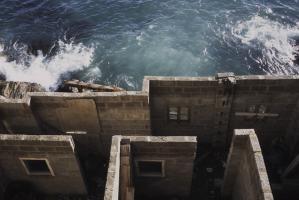
Mehdi Meddaci
LANCER UNE PIERRE
Art vidéo | | couleur | 22:0 | France | 2008
Comme un geste résiduel et diégétique.Comme un geste vers ce mur liquide qu?incarne la mer Méditerranée. Qui n?a jamais lancé une pierre afin de déclencher une vibration du monde ? Ou du moins de son image, pour encore pouvoir réactiver un lien sensible avec ce qu?il reste du réel? C?est alors que dans un espace en circuit fermé, entre l?image et le son, entre construction et déconstruction, immergé et émergé, que peuvent malgré tout coexister deux rives et quelques personnes lançant une pierre à l?endroit d?un manque.
Mehdi Meddaci né en 1980 Diplomé du Fresnoy Studio National des Arts Contemporains Diplomé de l?Ecole Nationale Supérieure de la Photographie, Arles Expositions Dec. 2008 Exposition collective «Dans la nuit, des images», Grand Palais, Paris Nov 2008 Festival internatioal de artes y culturas digitales de Gran Canaria Las palmas, îles Canaris Oct. 2008 festival international du cinéma Méditerranéen de Montpellier Festival «Temps d?images» la ferme du buisson, Paris Juin 2008 Exposition collective Panorama 9-10 Le Fresnoy studio national des arts contemporains Tourcoing Oct. 2007 Festival international du cinéma Méditerranéen de Montpellier Festival «Temps d?images» la ferme du buisson, Paris Juin 2007 Exposition collective Panorama 8 «Présumés coupables !» Le Fresnoy studio national des arts contemporains Tourcoing Janv. 2007 Exposition collectives «Duels» Frac PACA Marseille Sept. 2006 Montpellier Quartiers Libres, Parc du mas de la Paillade Fev. 2005 Exposition collective «Ludotype», Espace Van Gogh, Arles Sept. 2003 OFF du Printemps de Septembre Toulouse
Isiah Medina
Catalogue : 201688:88 | Doc. expérimental | 4k | couleur et n&b | 65:5 | Canada | 2015
Isiah Medina
88:88
Doc. expérimental | 4k | couleur et n&b | 65:5 | Canada | 2015
You cannot pay your bill. – . Your heat and lights are cut off. -. You pay. The clocks initially flash 88:88, –:–. You set the clocks. You cannot pay. -. You pay. 88:88. –:–. Repeat. 88:88, –:–. Cut. -. You stop setting your clock to the time of the world. 88:88, –:– . Subtracted: – : you make do with suspension. 88:88, –:–, -.
Isiah Medina was born in 1991 and he lives in Toronto.
Catalogue : 2014One One | Fiction expérimentale | 16mm | couleur | 5:5 | Canada | 2013
Isiah Medina
One One
Fiction expérimentale | 16mm | couleur | 5:5 | Canada | 2013
A philosopher is the child born under the divorce of being and thinking
Isiah Medina was born in 1991, went to university to receive debt and will always have been rabble.
Isiah Medina
Pavel Medvedev
Catalogue : 2008On the third planet from the sun | Doc. expérimental | dv | couleur | 31:0 | Russie | 2006

Pavel Medvedev
On the third planet from the sun
Doc. expérimental | dv | couleur | 31:0 | Russie | 2006
Russian North. People who are living in that district pick in the bog the ?space garbage?, sell the scrap metal or use it in the housekeeping and farming. In Arkhangelsk area, 45-years since nuclear bomb experiments, life is going its ordinary way.
Pavel Medvedev was born in 1963 in Orenburg (Russia). In 1990 he a full course of studies in LGIK (Leningrad?s Krupskaja Institute of Culture), specialized in film production at the Gorin?s workshop. Since 1990 till 1992 studied at the Higher Program of Television Production (workshop of V. Sarukhanov). Since 1991 till 2000 he was working at the TV and Radio companies of Saint-Petersburg as a producer. Since January till May 2001 was producing the serial of documentaries ?Petersburg?s short stories?. In February 2002 he has made his first professional documentary film ?Vacations in November?.
Vincent Meessen
Catalogue : 2008A Broken Rule | Vidéo expérimentale | dv | couleur | 2:6 | Belgique | 2007

Vincent Meessen
A Broken Rule
Vidéo expérimentale | dv | couleur | 2:6 | Belgique | 2007
Six personnages éclairent la nuit dans une ville africaine. Ils portent chacun un mot. Une fois assemblés, ces mots produisent une phrase, indistinctement poétique et cependant politique en même temps. Comme avec les autres projets de Vincent Meesen, "A Broken Rule" est tiré d'une intervention du public puis déformé par la mise en récit filmique de l'artiste, mélangeant les traditionnels codes et conventions. Comme un documentaire sur une expérience, cette vidéo est à la croisé des chemins entre la performance, la fiction, la musique expérimentale et le film documentaire, résultant en ce qui peut être lu comme un appel ou une invitation à une "transformation irrégulière".
Vincent Meessen
Catalogue : 2011Vita Nova | Fiction | dv | couleur | 26:56 | Belgique | 2009
Vincent Meessen
Vita Nova
Fiction | dv | couleur | 26:56 | Belgique | 2009
In his famous essay Mythologies(1957), Roland Barthes demystified the French colonial imperialism by means of a photograph that appeared on the cover of Paris-Match. This picture, that became an icon of modern criticism, shows a colonial cadet on guard.Vita Nova unveils the biographical ghost underneath the surface of this mythical picture. When recited, Barthes words reveal slowly their hidden meaning: the unmeasurable weight of an historically burdened heritage. Vita Nova is a spiral movie in which History (Histoire), now chaotic in its temporality, returns in a more certain form as story (histoire). The found Time of history is here the survival to the image. It is the now, the temporality of the living, the untimeliness of the reciter.
Vincent Meessen (U.S.A., 1971; lives in Brussels) produces work at the crossroads of the documentary and conceptual art, whose codes he manipulates in order to create hybrids he calls ?documents of experience?: films, texts, interventions, photographs, etc. He focuses on the cultural appropriation of usages, signs or documents, which he moulds and reshapes as narrative. His work is characterised by a recitative style in formats as diverse as the essay (Vita Nova), the fable (Dear Adviser) and the tale (Les Sociétaires). He has developed a poetics of re-reading and translation, wherein the document is transformed into experience and experience into a document. He often employs collaborative procedures which undermine the authority of the author and privilege the collective understanding of multiplicities. Vincent Meessen?s work has recently been the subject of a solo exhibition at the Stedelijk Museum Bureau Amsterdam (SMBA) and has been presented with the collective Potential Estate at the Brussels Biennial and at M HKA (off-site) in Anvers. His films have been widely screened at venues such as the Jeu de Paume and the Cinémathèque française in Paris, the Museo Reina Sofia in Madrid, the Swiss Institute in New York and in international festivals such as the IDFA in Amsterdam, the IFFR in Rotterdam, the Cinéma du Réel in Paris and Transmediale in Berlin. His films are distributed by par Argos centre for art & media in Brussels.
Christoph Meier
Catalogue : 2010ohne Titel (Filmsetperformancebühnefilm) | Vidéo | dv | couleur | 4:20 | Autriche | 2009
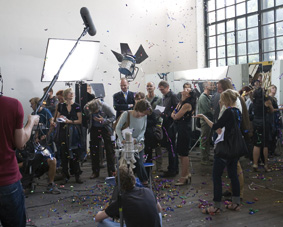
Christoph Meier
ohne Titel (Filmsetperformancebühnefilm)
Vidéo | dv | couleur | 4:20 | Autriche | 2009
Im Sinne einer zeitgenössischen Praxis als Kunstschaffender will sich eine Methode in unterschiedlichsten Medien darstellen lassen. Sie veranlasst Werkkategorien der eigenen Produktion zu ignorieren und darauf aufbauend die Grenzen dieser weiter zu verzerren. Im Medium Video oder Film besteht etwa in Form einer Story im Allgemeinen eine wesentlich stärkere Erwartungshaltung an Inhalt. Auf virtueller Ebene bringt solch eine gerichtete Konzentration zwischen Publikum und AutorIn diese Erwartungshaltung von Seiten der BetrachterInnen mit sich. Um diese Beziehung dann auch als Inhalt offenzulegen, ist es nötig den/die AutorIn sichtbar zu machen. So muss der Kunstschaffende im Medium Film sowohl in der Funktion des Autors/der Autorin, als auch in der des Schauspielers/der Schauspielerin - der ebenfalls sein Anliegen tragen kann - sichtbar werden. Das heißt die allgemeine Frage der AutorInnenschaft im Kontext eines Werkes weiterzutragen. AssistentIn, FotografIn, AuftragnehmerIn, AuftraggeberIn, KritikerIn oder GaleristIn rücken gemeinsam mit dem Autor/der AutorIn ins Bild und vor die Kamera. Um die Einflüsse all dieser Rollen weiterhin zuzulassen, ist es von wesentlicher Bedeutung sie in Echtzeit ? vor laufender Kamera ? selbstentscheidend mitwirken zu lassen. Jeder Darsteller/jede Darstellerin entscheidet für sich, in Abhängigkeit zum Autor/zur Autorin, den damit verbundenen Integrationsaufwand und das daraus entstehende gemeinsame Filmbild. Die Problematik gleichzeitig vor aber auch hinter der Kamera zu stehen löst ein großer Spiegel, dem Kamera und Akteure gegenüberstehen. Motiv des Bildes, optischer Inhalt, beziehungsweise Skript entstehen in Echtzeit um die Kamera.
Christoph Meier, geboren 1980 in Wien, hat schon während seines Architekturstudiums (1999-2005) an der Technischen Universität Wien ein Studium der textuellen Bildhauerei bei Heimo Zobernig an der Akademie der Bildenden Künste Wien (2003-2009) begonnen. 2008 kam ein Studienaufenthalt an der Glasgow School of Art hinzu. Heute lebt und arbeitet Meier als freischaffender bildender Künstler in Wien und beschäftigt sich genreübergreifend mit den Medien Architektur, Skulptur, Installation, Performance und Film. Bisher konnte Meier seine Arbeit im Rahmen einer intensiven Ausstellungstätigkeit im In- und Ausland zeigen, wobei zu den wichtigsten Ausstellungsorten der Kunstverein Braunschweig (2006), die Generali Foundation Wien (2006), das Groeningen Museum in Brügge (2007), das Nam June Paik Art Center in Seoul (2009) und für der kommende Jahr 2010 das Museum auf Abruf Wien sowie das Kunsthaus Graz (während des Diagonale Film Festivals) zählen. Dieses Jahr erhielt Christoph Meier den Förderpreis der Karl-Anton Wolf Stiftung und den Preis der Galerie Klatovy/Klenová (CZ).
Kim Mejdahl
Catalogue : 2025Sinrise | Vidéo | hdv | couleur | 3:0 | Danemark | 2023
Kim Mejdahl
Sinrise
Vidéo | hdv | couleur | 3:0 | Danemark | 2023
"Sinrise" (2023) is an experimental video by Danish artist Kim Richard Adler Mejdahl. Mejdahl stayed alone in BonBon-Land from sunset to sunrise to explore what happens when darkness descends in the old Danish theme park known for its grotesque characters. In the black interval we go on a cosmic rollercoaster ride among the stars while the cartoony inhabitants of the park seem to welcome the sun. "Sinrise" was recorded in infrared timelapse creating a haunted mood. The video suggests a way of portraying the sorrows of childhood nostalgia, and the eternal cycle of life and death.
Kim Richard Adler Mejdahl (b. 1989) graduated from the Royal Danish Academy of Fine Arts in 2019. Slaptstick humour and gothic horror meet up in Mejdahl's multifaceted work that often has its starting point in the artist's personal life story. Be it music album releases, film productions or large solo exhibition projects, Mejdahl's practice explore the topics of trauma-healing, climate crisis, spirituality, and gender identity. His video works have reached international audiences with screenings in France, Germany, Iceland, Norway, and South Korea. In 2018 Mejdahl received the Charlottenborg Spring Exhibition Solo Award,, and in 2022 he was awarded a spot at The Danish Art Foundation's talent programme The Young Artistic Elite. In 2021 he recieved the Elna & C.T. Hollesen's Foundation Grant. Mejdahl's work is part of Denmark's National Gallery's collection.
Kim Richard Adler Mejdahl
Catalogue : 2026Glory 1 | Vidéo expérimentale | 4k | couleur | 2:0 | Danemark | 2024
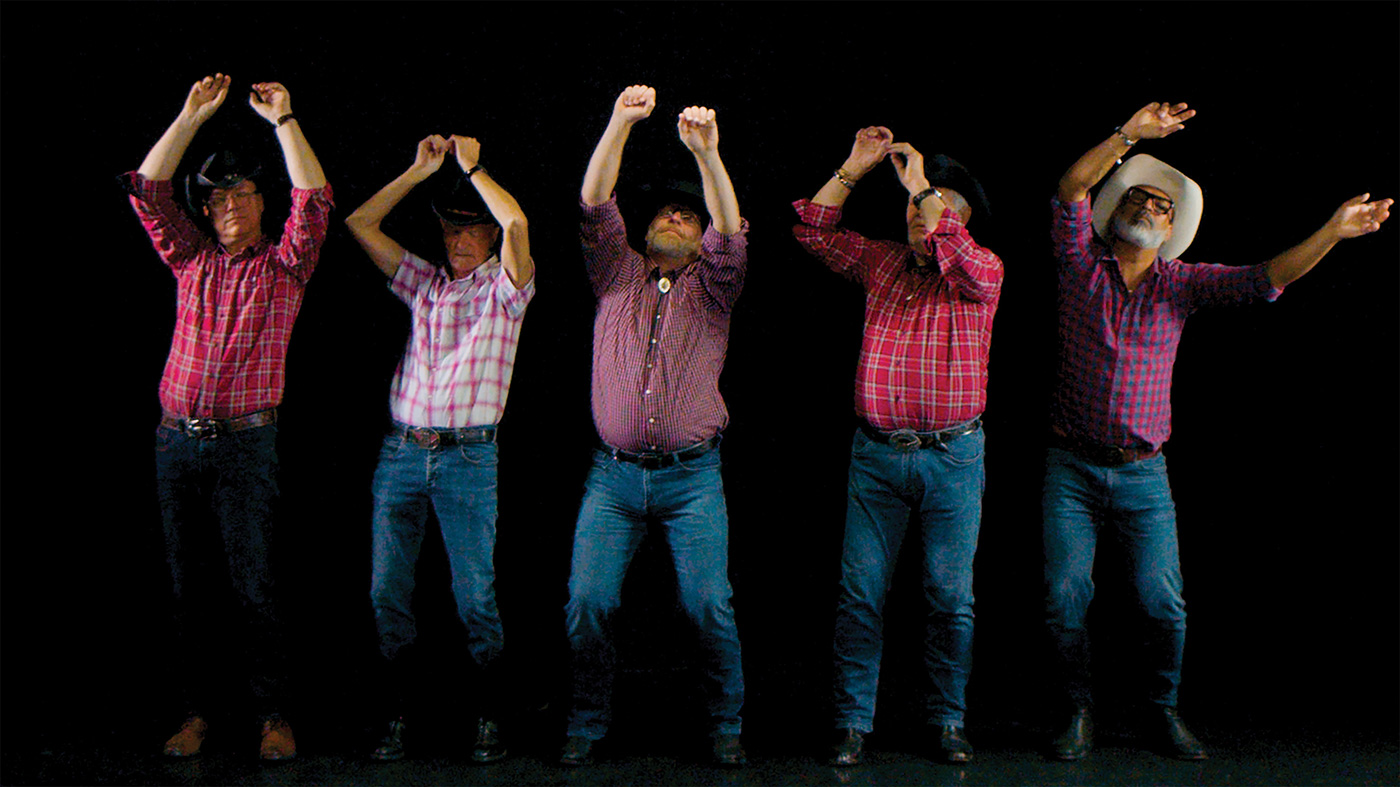
Kim Richard Adler Mejdahl
Glory 1
Vidéo expérimentale | 4k | couleur | 2:0 | Danemark | 2024
Les membres du club de gay linedance « Outliners » dansent dans une pièce noire. Glory 1 est une œuvre vidéo conçue par l’artiste danois pluridisciplinaire Kim Richard Adler Mejdahl. Le scénario onirique met en scène un antidote symbolique au patriarcat et à ses conceptions destructrices de la masculinité. Dans l’esprit de l’artiste, Glory 1 est un symbole de protestation. Voir des cowboys danser ensemble plutôt que de s’affronter devient un geste subversif contre les conceptions conventionnelles de l’homme. C’est une manière de renverser l’idéal macho du patriarcat — celui qui pèse sur les hommes et dicte leurs existences.
Kim Richard Adler Mejdahl est diplômé de la Royal Danish Academy of Fine Arts depuis 2019. Son œuvre protéiforme mêle humour slapstick et horreur gothique, souvent à partir de récits issus de sa propre histoire personnelle. Qu’il s’agisse de sorties d’albums musicaux, de productions filmiques ou de vastes projets d’expositions monographiques, la pratique de Mejdahl explore des thèmes tels que la guérison des traumas, notre relation à la nature, la spiritualité et l’identité de genre. Ses œuvres vidéo ont touché des publics internationaux, avec des projections à travers l’Europe et l’Asie. Sous le nom d’artiste Kim Kim, Mejdahl a réalisé de nombreuses performances live et publié plusieurs albums musicaux. En quelques années, il a collaboré avec un large éventail d’institutions, parmi lesquelles Kunsthal Charlottenborg, le Roskilde Festival, le parc d’attractions danois BonBon-Land, le théâtre Sort/Hvid, et plus récemment KØN – Gender Museum Denmark. En 2025, Mejdahl a reçu la bourse de travail triennale de la Danish Arts Foundation. Son travail est également présent dans la collection de la Galerie nationale du Danemark.
Catalogue : 2022Hour of Moth (Etude no. II) | Vidéo | 4k | couleur | 11:10 | Danemark | 2020
Kim Richard Adler Mejdahl
Hour of Moth (Etude no. II)
Vidéo | 4k | couleur | 11:10 | Danemark | 2020
A human being (the artist himself) lies half-naked on a forest floor, facing the viewer while gently singing. On his body rests a throng of colorful moths whose fluttering wings generate a melody attuned to the song. With its prolonged visual intro and lyrical song, Hour of Moth (Etude no. II) takes the form of a music video where Mejdahl himself is both the singer and songwriter. The work is a love song to the angel of the night—the moth—but also a yearning and sensual hymn to all nature. Mejdahls claims the geometric patterns on moth wings to be hidden warning messages from nature itself, but humans struggle to comprehend them. Hour of Moth (Etude. no II) thus looks upon the current climate crisis in which the human race feel detatched from Nature, while still searching for hope in the dark. This video art piece was made for Mejdal’s solo exhibition Liljegrotten (Lillith Grotto) at Overgaden Institute for Contemporary Art, Copenhagen (2021). The same year Hour of Moth (Etude no. II) was aqcuired by by The Museum of Contemporary Art (Museum for Samtidskunst), and The Danish Arts Foundation.
Copenhagen-based visual artist, filmmaker, and electronic music composer Kim Richard Adler Mejdahl was born in the Danish village Skælskør. With an educational background in fine arts Mejdahl has created a wide range of critically acclaimed artworks that interweave genres and media. In 2018 Mejdahl received The Jury’s Solo Award at Charlottenborg’s Spring Exhibition for his horror-musical documentary ODE - featuring the artist’s entire family that sing about their deceased abusive father. The movie was later aqcuired by The National Gallery of Denmark (Statens Museum for Kunst). Mejdahl’s largest production consists of his debut arthouse feature DAYS OF AL from 2019 - an experimental horror film starring the artist’s cousin and puppy dachshund as leading actors. Both movies come with its own soundtrack released by the artist’s music alias Kim Kim. This summer Mejdahl will release Liljegrotten - a music album and Denmark’s largest collectively produced sound piece made entirely out of audience sound recordings generated at the artist’s latest solo exhibition at Overgaden Institute of Contemporary Art.
Miguel Mejias
Catalogue : 2021The Foundation | Film expérimental | mov | couleur | 34:8 | Espagne, Royaume-Uni | 2020
Miguel Mejias
The Foundation
Film expérimental | mov | couleur | 34:8 | Espagne, Royaume-Uni | 2020
Conduit par une voix virtuelle, un homme ordinaire trouve refuge dans les bois. Là, il tentera de comprendre le mystère de sa situation.
Miguel Mejías (né en 1991 à Tenerife, Espagne) a étudié l’écriture de scénario à Madrid après avoir fait des études de sociologie et de communication. Après une série d'autres emplois comme chauffeur, promoteur culturel, docker, ouvrier de chantier, éditeur ou encore restaurateur d’objets historiques, il est actuellement professeur de cinéma et de littérature à Sundsvall, en Suède. Ses réalisations ont été sélectionnées dans des festivals internationaux tels que le Trieste Film Festival (Italie); Cinespaña, Toulouse (France); Experimental Superstars, Novi Sad (Serbie); le Festival Internacional de Cine de Las Palmas de Gran Canaria (Espagne); le Festival de Málaga (Espagne); la Mostra de Cinema Mediterraneo, Valence (Espagne); le Ismailia Film Fest, Ismaïlia (Égypte); le Festival de Cine de Bogotá (Colombie) ou encore le Festival de Buenos Aires (Argentine).
Jonas Mekas
Catalogue : 2010NOTES ON AN AMERICAN FILM DIRECTOR AT WORK | Vidéo | dv | couleur | 60:0 | USA | 2009
Jonas Mekas
NOTES ON AN AMERICAN FILM DIRECTOR AT WORK
Vidéo | dv | couleur | 60:0 | USA | 2009
Bjørn Melhus
Catalogue : 2018Moon Over Da Nang | Doc. expérimental | hdv | couleur | 15:0 | Norvège, Allemagne | 2016
Bjørn Melhus
Moon Over Da Nang
Doc. expérimental | hdv | couleur | 15:0 | Norvège, Allemagne | 2016
Towards the end of the 1960ies the world witnessed the war in Vietnam through what can still be called one of the largest ever TV war spectacles. At the very same time American astronauts looked down on Earth from the moon for the first time in human history. Although initially intended as affirming American dominance in the cold war this first view on the blue planet as whole created an image that quickly became the icon of ecological thought and central to a whole movement of counter culture. MOON OVER DA NANG draws these two contrasting media events together in Melhu’s own quirky and experimental quest to come to grips with the country’s post-socialist present in the throughway between the past and the future. Interviews with residents and dreamlike associative sequences are mixed with the documentation of the production process of a life-sized marble sculpture in Da Nang, a city in central Vietnam, which, 40 years after the end of the war in Vietnam, is being discovered by international investors for the tourism business. Traces of the past and of the war are gradually covered up by the construction of hotels and luxury resorts. At the end of the film the marble sculpture receives its finishing touches and turns out to be an Apollo astronaut.
Bjørn Melhus was born in Kirchheim unter Teck in 1966 and studied Fine Arts with a major in Film/Video at the Braunschweig University of Art from 1990 to 1997. He was a fellow of the DAAD at the California Institute of the Arts in Los Angeles and of the federal state of Lower Saxony in ISCP, New York. He participated in exhibitions at the Whitney Museum in New York, the 8th International Biennial of Istanbul, the Venice Biennial in (1998/2011), the FACT in Liverpool, the Serpentine Gallery in London, the Sprengel Museum in Hanover, the Ludwig Museum in Cologne, the ZKM in Karlsruhe, the Denver Art Museum, as well as others. Bjørn Melhus has been a professor of Fine Arts/Virtual Realities at the School of Art and Design Kassel since 2003. Bjørn Melhus has been living and working in Berlin since 1987. In his short films and installations, Bjørn Melhus focuses on general global ideas and trends, the critical reception of mass media, as well as the direct effects they have on people. He uses footage from film and television excessively and deconstructs stereotypical themes, figures and patterns of perception through means of exaggeration. At the same time, he breaks up a seemingly fixed relationship between media and audience, thus opening up the view on the essentials of human interaction.
Catalogue : 2012I'm Not The Enemy | 0 | 0 | | 13:30 | Norvège, Allemagne | 2011
Bjørn Melhus
I'm Not The Enemy
0 | 0 | | 13:30 | Norvège, Allemagne | 2011
Bjørn Melhus, born 1966, is a German-Norwegian media artist. In his work he has developed a singular position, expanding the possibilities for a critical reception of cinema and television. His practice of fragmentation, destruction, and reconstitution of well-known figures, topics, and strategies of the mass media opens up not only a network of new interpretations and critical commentaries, but also defines the relationship of mass media and viewer anew. Originally rooted in an experimental film context, Bjørn Melhus's work has been shown and awarded at numerous international film festivals. He has held screenings at Tate Modern and the LUX in London, the Museum of Modern Art (MediaScope) in New York, and the Centre Pompidou in Paris, amongst others. His work has been exhibited in shows like The American Effect at the Whitney Museum New York, the 8th International Istanbul Biennial, solo and group shows at FACT Liverpool, Serpentine Gallery London, Sprengel Museum Hanover, Museum Ludwig Cologne, ZKM Karlsruhe, Denver Art Museum among others.
Bjørn Melhus
Catalogue : 2014Sudden Destruction | Vidéo expérimentale | hdcam | couleur | 4:20 | Allemagne | 2012
Bjørn Melhus
Sudden Destruction
Vidéo expérimentale | hdcam | couleur | 4:20 | Allemagne | 2012
A man in a hotel. A newscaster. A corpse under a bed sheet, which suddenly awakens and postulates the advent of "sudden destruction". Speech is gushing out in the rhetoric of the apocalypse taking itself to the absurd. The quotes are taken from YouTube videos of self-proclaimed evangelist prophets.
Bjørn Melhus, born 1966, is a German-Norwegian media artist. In his work he has developed a singular position, expanding the possibilities for a critical reception of cinema and television. His practice of fragmentation, destruction, and reconstitution of well-known figures, topics, and strategies of the mass media opens up not only a network of new interpretations and critical commentaries, but also defines the relationship of mass media and viewer anew. Originally rooted in an experimental film context, Bjørn Melhus`s work has been shown and awarded at numerous international film festivals. He has held screenings at Tate Modern and the LUX in London, the Museum of Modern Art (MediaScope) in New York, and the Centre Pompidou in Paris, amongst others. His work has been exhibited in shows like The American Effect at the Whitney Museum New York, the 8th International Istanbul Biennial, solo and group shows at FACT Liverpool, Serpentine Gallery London, Sprengel Museum Hanover, Museum Ludwig Cologne, ZKM Karlsruhe, Denver Art Museum among others. Since 2003 he has been professor for Virtual Realities at the School of Art Kassel, Germany. Bjørn Melhus lives in Berlin.
Catalogue : 2013Afterlife | Vidéo | hdv | couleur | 7:10 | Allemagne, USA | 2010
Bjørn Melhus
Afterlife
Vidéo | hdv | couleur | 7:10 | Allemagne, USA | 2010
Vast desert expanses extend out in our imaginations as life after death, the white blinding light transforming the mere mortal into the eternal. The curtains go down but the brilliance of the spirit lives on, truly free amongst the sweeping winds and blowing dust. Judy Garland, Jim Morrison, Big Jim and even you?the essence of life may be meaningless but there is unspeakable beauty in its demise.
Bjørn Melhus, born 1966, is a German-Norwegian media artist. In his work he has developed a singular position, expanding the possibilities for a critical reception of cinema and television. His practice of fragmentation, destruction, and reconstitution of well-known figures, topics, and strategies of the mass media opens up not only a network of new interpretations and critical commentaries, but also defines the relationship of mass media and viewer anew. Originally rooted in an experimental film context, Bjørn Melhus`s work has been shown and awarded at numerous international film festivals. He has held screenings at Tate Modern and the LUX in London, the Museum of Modern Art (MediaScope) in New York, and the Centre Pompidou in Paris, amongst others. His work has been exhibited in shows like The American Effect at the Whitney Museum New York, the 8th International Istanbul Biennial, solo and group shows at FACT Liverpool, Serpentine Gallery London, Sprengel Museum Hanover, Museum Ludwig Cologne, ZKM Karlsruhe, Denver Art Museum among others.
Marina Meliande, Felipe Bragança
Catalogue : 2006O Nome Dele (o clovis) | Fiction | 35mm | couleur | 15:0 | Brésil | 2004
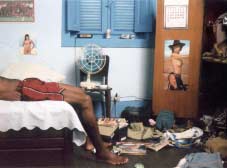
Marina Meliande, Felipe Bragança
O Nome Dele (o clovis)
Fiction | 35mm | couleur | 15:0 | Brésil | 2004
Ils se sont rencontrés en été, sous la pluie. Un film sur le silence et le carnaval. Sur la colère et la joie. Un hommage passionné à la surface de Rio de Janeiro : plein de douleur, de rêves et de tristesse. Une histoire carnavalesque d'amour et de violence. Créée à travers le silence criant qui entoure notre ville comme un masque interminable.
Felipe Bragança et Marina Meliande, 24 ans, font tous les deux partie de la nouvelle génération de critiques de films et réalisateurs brésiliens. Bragança et Meliande avaient réalisé ensemble deux courts-métrages primés et avaient produit d'importants festivals de films à Rio de Janeiro. Bragança vient de terminer son premier scénario de long-métrage et a travaillé comme assistant-réalisateur et coscénariste sur le second long-métrage de Karim Aiznou (" Madame Satã"). Marina Meliande est spécialisée dans le montage son et image, et travaille avec de grands monteurs de films au Brésil. Elle prépare actuellement, avec Felipe Bragança, son premier long-métrage.
Melter 2